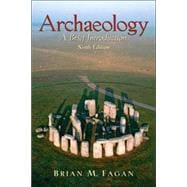
| Preface | xi | ||||
| Author's Note | xv | ||||
| About the Author | xvii | ||||
| chapter one Fossils, Cities, and Civilizations: The Birth of a Science | 1 | (25) | |||
|
4 | (1) | |||
|
4 | (5) | |||
|
9 | (5) | |||
|
14 | (4) | |||
|
18 | (1) | |||
|
19 | (3) | |||
|
22 | (2) | |||
|
24 | (2) | |||
| chapter two Introducing Archaeology and Prehistory | 26 | (26) | |||
|
27 | (6) | |||
|
33 | (1) | |||
|
34 | (3) | |||
|
37 | (1) | |||
|
38 | (8) | |||
|
46 | (5) | |||
|
51 | (1) | |||
| chapter three Culture and Context | 52 | (21) | |||
|
53 | (3) | |||
|
56 | (5) | |||
|
61 | (2) | |||
|
63 | (3) | |||
|
66 | (4) | |||
|
70 | (2) | |||
|
72 | (1) | |||
| chapter four Explaining the Past | 73 | (22) | |||
|
74 | (6) | |||
|
80 | (2) | |||
|
82 | (2) | |||
|
84 | (4) | |||
|
88 | (6) | |||
|
94 | (1) | |||
| chapter five Space and Time | 95 | (26) | |||
|
96 | (5) | |||
|
101 | (2) | |||
|
103 | (6) | |||
|
109 | (2) | |||
|
111 | (9) | |||
|
120 | (1) | |||
| chapter six Finding Archaeological Sites | 121 | (23) | |||
|
122 | (5) | |||
|
127 | (1) | |||
|
127 | (3) | |||
|
130 | (2) | |||
|
132 | (2) | |||
|
134 | (5) | |||
|
139 | (1) | |||
|
140 | (2) | |||
|
142 | (2) | |||
| chapter seven Excavation | 144 | (25) | |||
|
145 | (3) | |||
|
148 | (6) | |||
|
154 | (2) | |||
|
156 | (1) | |||
|
156 | (3) | |||
|
159 | (8) | |||
|
167 | (1) | |||
|
168 | (1) | |||
| chapter eight Classification and Technology | 169 | (31) | |||
|
170 | (1) | |||
|
171 | (2) | |||
|
173 | (1) | |||
|
174 | (10) | |||
|
184 | (1) | |||
|
185 | (3) | |||
|
188 | (10) | |||
|
198 | (2) | |||
| chapter nine The Present and the Past | 200 | (24) | |||
|
202 | (1) | |||
|
203 | (3) | |||
|
206 | (8) | |||
|
214 | (1) | |||
|
215 | (1) | |||
|
216 | (1) | |||
|
217 | (4) | |||
|
221 | (2) | |||
|
223 | (1) | |||
| chapter ten Ancient Climate and Environment | 224 | (21) | |||
|
225 | (1) | |||
|
226 | (6) | |||
|
232 | (3) | |||
|
235 | (1) | |||
|
236 | (7) | |||
|
243 | (1) | |||
|
244 | (1) | |||
| chapter eleven Come Tell Me How You Lived | 245 | (19) | |||
|
246 | (1) | |||
|
247 | (2) | |||
|
249 | (8) | |||
|
257 | (3) | |||
|
260 | (2) | |||
|
262 | (1) | |||
|
263 | (1) | |||
| chapter twelve Settlement, Landscape, and Trade | 264 | (24) | |||
|
266 | (12) | |||
|
278 | (1) | |||
|
279 | (1) | |||
|
280 | (6) | |||
|
286 | (2) | |||
| chapter thirteen The Archaeology of People | 288 | (23) | |||
|
290 | (2) | |||
|
292 | (7) | |||
|
299 | (3) | |||
|
302 | (2) | |||
|
304 | (6) | |||
|
310 | (1) | |||
| chapter fourteen Archaeology and You | 311 | (12) | |||
|
312 | (4) | |||
|
316 | (1) | |||
|
317 | (2) | |||
|
319 | (2) | |||
|
321 | (1) | |||
|
322 | (1) | |||
| Sites and Cultures Mentioned in the Text | 323 | (6) | |||
| Glossary of Technical Terms | 329 | (10) | |||
| Guide to Further Reading | 339 | (11) | |||
| References | 350 | (1) | |||
| Credits | 351 | (2) | |||
| Index | 353 |
The New copy of this book will include any supplemental materials advertised. Please check the title of the book to determine if it should include any access cards, study guides, lab manuals, CDs, etc.
The Used, Rental and eBook copies of this book are not guaranteed to include any supplemental materials. Typically, only the book itself is included. This is true even if the title states it includes any access cards, study guides, lab manuals, CDs, etc.